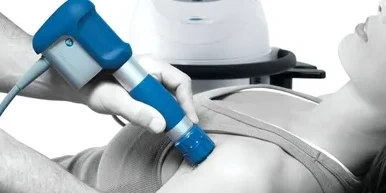The physiotherapist utilizes a device to deliver repetitive pulses through the skin tissue to the area that needs to be treated. The size and form of the tip on the handpiece he employs change depending on the treated area. In the short term, a decrease in pain appears quickly and lasts 24 to 48 hours. Two mechanisms are responsible;
Release by the body of endorphins and pain-inhibiting substances.Inhibition of neurological stimuli in the spinal cord (Gate Control theory).In the long term, Shockwave therapy Hamilton offers a defibrating action of the tissues and a hypervascularization at the origin of an increase in the local metabolism favouring better healing. These long-term effects are sought after and require several weeks to obtain (4 to 6 weeks on average).
Shockwaves: what are they?
Shockwaves are mechanical pressure impulses that travel in waves through the human body. This treatment consists of broadcasting high-energy extracorporeal acoustic waves. Diffused through the skin directly into the tissues, they allow them to regenerate and heal certain wounds more quickly. The Shockwave therapy Hamilton generates inflammation which stimulates the tissues and their healing. Today there are different types of shock waves:
Shockwave therapy has many advantages, such as:
. A faster recovery which does not necessarily require a cessation of training, especially in high-level athletes;
. It is a non-invasive treatment requiring neither medication nor anaesthesia;
. Shorter treatment duration and with very few side effects.
Patients often apprehend shock waves, but this method is not painful. It is also suitable for all types of patients, children and adults. Thus, the physiotherapist must adapt the intensity of the shock waves to the patient during the treatment.
Shock waves: what actions are on the body?
Shock waves act in several ways on the body. They are suitable for treating various anomalies such as tendinopathy, calcifications, muscle fibrosis, and sports injuries. The shock waves have, first of all, an analgesic action. Indeed, repeated shocks allow the release of endorphins at the local level. Thus, the pain during the session is reduced.
The shock waves also have a defibrotic action on the tissues. Indeed, they allow faster healing thanks to the creation of micro-lesions and the overproduction of collagen. The tendons heal quicker and are stronger and more resistant. This treatment also has a vascular action. There is an increase in the proteins responsible for growth, such as eNOS, VEGF or BMP. The secretion of these proteins will thus allow the creation of new arterioles, facilitating blood supply and optimal oxygenation during healing.
Finally, the shock waves have a decalcifying effect on the tendon. Thus, the acoustic waves make it possible to cause a blood supply around the calcification area. Calcification is a deposit and fixation of calcareous salts in organic tissues, particularly tendons, resulting in chronic tendonitis.
Its application in sports medicine makes it possible to treat all musculoskeletal conditions and chronic conditions such as muscle distension, joint injuries, and hip or lower back pain, and the iliotibial band syndrome.
Thus, shock waves have revolutionized sports medicine treatments, making them more effective and providing faster healing and scarring. This method allows top athletes to continue their training during their recovery.
Shock wave healing
Tendinitis and Tendinopathies
It is a common condition in athletes, people whose professional activity involves physical activity, or in cases of repeated bad posture. The treatment of tendinitis by shock waves consists in applying percussion (such as a blowpipe, with air propelled on a ball which will hammer the damaged part) on the affected tendon to create micro-lesions to revascularize the area and accelerate the healing process.
Shock wave therapy is indicated in the treatment of tendinopathies and the prevention of complications (tendon rupture): patellar tendinitis, Achilles tendinitis (of the Achilles tendon), tennis elbow (epicondylitis), plantar fasciitis, wrist tendonitis, shoulder tendonitis.
It is also possible to use shock waves in the event of trochanteric bursitis, shoulder calcification or muscle damage. It takes between 3 and 5 sessions for the fastest. However, if tendonitis is developed, more sessions will be required.
Calcaneal spur
On x-rays, a bony growth in the shape of a thorn appears below the heel (calcaneus). In case of strong tensions on foot, the thorn seems because of the slightest crack or tiny wound, which the body seeks to repair by bone fixation (limestone deposit). If excessive or improper tension persists, the tissue surrounding the growth may become inflamed and painful.


